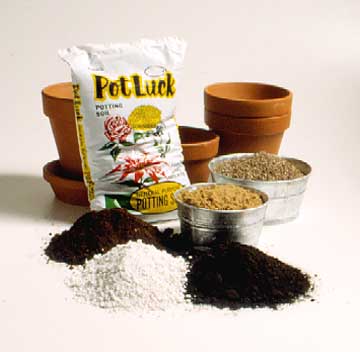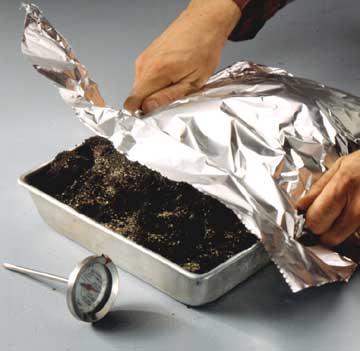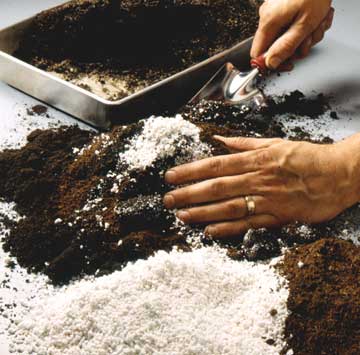





 Buy potting soils of variousmakeups premixed, or mix yourown, using the ingredients thatwork best for you.
Buy potting soils of variousmakeups premixed, or mix yourown, using the ingredients thatwork best for you.
The ideal potting mix is solid enough to anchor roots, but loose enough to allow quick root growth, good drainage, and the free flow of air. It also retains moisture without getting soggy.
Traditionally houseplant potting mixes contain no soil at all; instead, they're made of peat moss, vermiculite, and perlite. Peat moss is light and absorbs lots of water, keeping the growing medium moist. The perlite and vermiculite act as spacers so that roots can grow freely. It also keeps the soil from compacting and becoming waterlogged.
Test Garden Tip: Dry peat moss sheds water. When moistening peat for the first time, use warm water or let peat moss soak and slowly absorb the moisture.
Many other materials can replace these three components. Coarse sand is of the most common. Shredded bark and charcoal are used in special instances, as for growing orchids and bromeliads. To replace peat moss, some gardeners use compost, leaf mold (decomposed leaves), or rotted horse manure.
Learn how to make your own potting soil!
Buy or make your own potting mix. Either way, be sure the mix has been sterilized to kill disease and weed seeds. Most (not all) potting mixes you buy at the store are sterile. Read packages carefully; if a potting mix is sterile, the package will say so. You can sterilize your own mix at home by baking pans of soil and other ingredients in an oven, but be prepared: It's a messy, smelly, time-consuming job.
Note that potting mix is a generic term. There is a wide range of materials used in making potting mixes, with little uniformity from product to product. You may wish to try several to discover which you like best.
The pH (relative acidity or alkalinity) of soils is rarely a problem for most indoor plants. Repeated watering with hard water can cause soil to turn alkaline. If your water is hard, replace potting mix annually or treat with a fertilizer made for acid-loving houseplants. Note that some plants -- particularly azalea, gardenia, and camellia -- must have acid soil to grow properly.
 Step 1
Step 1
1. Sterilize garden earth before mixing in other ingredients. Place in pan, seal with foil, and bake in a 200-degree F oven until a meat thermometer registers 150 to 180 degrees F for 30 minutes. If other ingredients aren't sterile, mix with earth and bake.
 Step 2
Step 2
2. Once ingredients are sterile and cool, thoroughly mix equal parts garden soil, perlite, and peat moss. This mixture yields an all-purpose potting soil. Vary ingredients and proportions for special plants, like cactus and orchid.
Copyright © www.100flowers.win Botanic Garden All Rights Reserved